Elementary Error Model Applied to Terrestrial Laser Scanning Measurements: Study Case Arch Dam Kops
Abstract
1. Introduction
2. Elementary Error Model Theory
2.1. General Remarks about Stochastic Models
2.2. Elementary Error Theory
3. Elementary Error Theory for Terrestrial Laser Scanners
3.1. Error Soruces in Terrestrial Laser Scanning
3.2. Instrumental Elementary Errors
3.3. Meteorological Elementary Errors
3.3.1. Influences on the Distance Measurement
3.3.2. Influences on the Vertical Angle Measurement
3.4. Atmospheric Errors as Stochastic Correlating Errors
4. Study Case: Arch Dam Kops
4.1. Error of Position
4.2. Spatial Correlations Along Vertical Sections
4.3. Contribution of the Elementary Errors Variances to the Overall Error Budget
5. Conclusions
- the functional model was adapted for the instrumental errors of the Riegl VZ-2000 scanner;
- a deterministic approach was used to consider the spatial distribution of the atmospheric errors;
- the atmospheric elementary errors were included in the EEM as stochastic correlating errors;
- the error of position was presented in relation to the scanner position (geometric configuration) and yielded average values between 9 mm and 37 mm for ranges of 88 m to 456 m;
- spatial correlations have been analyzed with respect to a vertical section in each case;
- the contribution of individual error sources outlined the fact that instrumental errors have the biggest impact on the error of position.
Author Contributions
Funding
Acknowledgments
Conflicts of Interest
References
- Uren, J.; Price, B. Surveying for Engineers, 5th ed.; Palgrave Macmillan: New York, NY, USA, 2010. [Google Scholar]
- Kuhlmann, H.; Schwieger, V.; Wieser, A.; Niemeier, W. Engineering Geodesy-Definition and Core Competencies. J. Appl. Geod. 2014, 8, 327–334. [Google Scholar] [CrossRef][Green Version]
- Ogundare, J.O. Precision Surveying: The Principles and Geoamtics Practice; John Wiley & Sons, Inc.: Hoboken, NY, USA, 2016; pp. 8–13. [Google Scholar]
- Wunderlich, T.; Niemeier, W.; Wujanz, D.; Holst, C.; Neitzel, F.; Kuhlmann, H. Areal Deformation Analysis from TLS Point Clouds–The Challenge. Allg. Vermess. 2016, 123, 340–351. [Google Scholar]
- Paffenholz, J.A.; Stenz, U.; Wujanz, D.; Neitzel, F.; Neumann, I. 3DPunktwolken-basiertes Monitoring von Infrastrukturbauwerken am Beispiel einer historischen Gewölbebrücke. In Proceedings of the TLS 2017 Seminar DVW-Schriftreihe, Band 88/2017, Fulda, Germany, 11–12 December 2017. [Google Scholar]
- Kermarrec, G.; Alkhatib, H.; Neumann, I. On the Sensitivity of the Parameters of the Intensity-Based Stochastic Model for Terrestrial Laser Scanner. Case Study: B-Spline Approximation. Sensors 2018, 18, 2964. [Google Scholar] [CrossRef] [PubMed]
- Harmening, C.; Neuner, H. A spatio-temporal deformation model for laser scanning point clouds. J. Geod. 2020, 94, 26. [Google Scholar] [CrossRef]
- Mettenleiter, M.; Härtl, F.; Kresser, S.; Fröhlich, C. Laserscanning—Phasenbasierte Lasermesstechnik für die Hochpräzise und Schnelle Dreidimensionale Umgebungserfassung; Süddeutscher Verlag onpact GmbH: Munich, Germany, 2015; pp. 4–5. [Google Scholar]
- Staiger, R. Terrestrial Laser Scanning Technology-Systems and Applications. In Proceedings of the 2nd FIG Regional Conference, Marrakech, Morocco, 2–5 December 2003. [Google Scholar]
- Wieser, A.; Pfaffenholz, J.-A.; Neumann, I. Sensoren, Features und Physik-Zum aktuellen Stand der Entwicklung bei Laserscannern. In Proceedings of the TLS 2019 Seminar, DVW-Schriftreihe, Band 96/2019, Fulda, Germany, 2–3 December 2019. [Google Scholar]
- Kuhlmann, H.; Holst, C. Flächenhafte Abtastung mit Laserscanning-Messtechnik, flächenhafte Modellierung und aktuelle Entwicklungen im Bereich des terrestrischen Laserscanning. In Ingenieurgeodäsie-Handbuch der Geodäsie; Schwarz, W., Ed.; Springer: Berlin, Germany, 2018; pp. 203–205. [Google Scholar]
- Neuner, H.; Holst, C.; Kuhlmann, H. Overview on Current Modelling Strategies of Point Clouds for Deformation Analysis. Allg. Vermess. 2016, 123, 328–339. [Google Scholar]
- Borovkov, K. Elements of Stochastic Modelling; World Scientific Publishing Co. Pte. Ltd.: Singapore, 2014; pp. 3–4. [Google Scholar]
- Niemeier, W. Ausgleichungsrechnung, 2nd ed.; Walter de Gruyter: Berlin, Germany, 2008; pp. 31–33. [Google Scholar]
- Matthias, H.J. Bedeutung und Konstruktion von Kovarianzen in der Messtechnik. Ph.D. Thesis, Institut für Geodäsie und Photogrammetrie an der Eidgenössischen Technischen Hochschule Zürich, Mitteilungen Nr. 41, Zürich, Switzerland, 1992. [Google Scholar]
- Zhao, X.; Kermarrec, G.; Kargoll, B.; Alkhatib, H.; Neumann, I. Influence of the simplified stochastic model of TLS measurements on geometry-based deformation analysis. J. Appl. Geod. 2019, 13, 199–214. [Google Scholar] [CrossRef]
- Kauker, S.; Schwieger, V. A synthetic covariance matrix for monitoring by terrestrial laser scanning. J. Appl. Geod. 2017, 11, 77–87. [Google Scholar] [CrossRef]
- Schweitzer, J.; Schwieger, V. Modeling and Propagation of Quality Parameters in Engineering Geodesy Processes in Civil Engineering. In Proceedings of the 1st International Workshop on the Quality of Geodetic Observation and Monitoring Systems, Munich, Germany , 13–15 April 2011; Kutterer, H., Seitz, F., Alkhatib, H., Schmidt, M., Eds.; Springer: Cham, Switzerland, 2015. [Google Scholar]
- ISO/IEC Guide 98-3:2008: Uncertainty of Measurement—Part 3: Guide to the Expression of Uncertainty in Measurement (GUM:1995); International Organization for Standardization: Genève, Switzerland, 2008.
- Metropolis, N.; Ulam, S. The Monte Carlo Method. J. Am. Stat. Assoc. 1949, 44, 335–341. [Google Scholar] [CrossRef] [PubMed]
- Pelzer, H. Grundlagen der Mathematischen Statistik und der Ausgleichungsrechung. In Geodätische Netze in Landes- und Ingenieurvermessung; Pelzer, H., Ed.; Konrad Wittwer: Stuttgart, Germany, 1985. [Google Scholar]
- Koch, K.R. Determining uncertainties of correlated measurements by Monte Carlo simulations applied to laserscanning. J. Appl. Geod. 2008, 2, 139–147. [Google Scholar] [CrossRef]
- Aichinger, J.; Schwieger, V. Influence of scanning parameters on the estimation accuracy of control points of B-spline surfaces. J. Appl. Geod. 2018, 12, 157–167. [Google Scholar] [CrossRef]
- Förstner, W. Ein Verfahren zur Schätzung von Varianz-und Kovarianzkomponenten. Allg. Vermess. 1979, 86, 446–453. [Google Scholar]
- Koch, K.R. Parameterschätzung Und Hypothesentests in Linearen Modellen, 1st ed.; Ed. Dümmler: Bonn, Germany, 1980; pp. 245–259. [Google Scholar]
- Teunissen, P.J.G.; Amiri-Simkooei, A.R. Least-squares variance component estimation. J. Geod. 2008, 82, 65–82. [Google Scholar] [CrossRef]
- Niemeier, W.; Hollman, R. Haputkomponenten- und Sensitivitätsanalyse Geodätischer Netzte aufgezeigt am Überwachungsnetz Varna; WAdFV Hanover, Nr. 133; Hanover, Germany, 1984; pp. 61–72. [Google Scholar]
- Saltelli, A.; Chan, K.; Scott, E.M. (Eds.) Sensitivity Analysis, 1st ed.; John Wiley and Sons: New York, NY, USA, 2000. [Google Scholar]
- Hagen, G. Gründzuge der Wahrscheinlichkeits-Rechnung; Ed. Dümmler: Berlin, Germany, 1837. [Google Scholar]
- Bessel, F.W. Untersuchung über die Wahrscheinlichkeit der Beobachtungsfehler. Astron. Nachr. 1837, 15, 369–404. [Google Scholar]
- Schwieger, V. Ein Elementarfehlermodell für GPS Überwachungsmessungen; Schriftenreihe der Fachrichtung Vermessungswesen der Universität Hannover: Hanover, Germany, 1999; Volume 231. [Google Scholar]
- Augath, W. Lagenetze, Geodätische Netze in Landes-und Ingenieurvermessung. In Geodätische Netze in Landes-und Ingenieurvermessung; Pelzer, H., Ed.; Konrad Wittwer: Stuttgart, Germany, 1985. [Google Scholar]
- Schwieger, V. Determination of Synthetic Covariance Matrices–An Application to GPS Monitoring Measurements. In Proceedings of the 15th European Signal Processing Conference EUSIPCO 2007, Poznan, Poland, 3–7 September 2007. [Google Scholar]
- Rüeger, J.M. Electronic Distance Measurement: An Introduction, 3rd totally revised ed.; Springer: Berlin, Germany, 1990. [Google Scholar]
- Jutzi, B. Analyse der zeitliche Signalform von Rückgestreuten Laserpulse. Ph.D. Thesis-DGK, Reihe C, Heft Nr. 611, Technical University of Munich, Munich, Germany, 2007. [Google Scholar]
- Soudarissanane, S.S. The Geometry of Terrestrial Laser Scanning-identification of Errors, Modeling and Mitigation of Scanning Geometry. Ph.D. Thesis, Technical Universit of Delf, Delft, The Netherlands, 2016. [Google Scholar]
- Chow, J.C.K.; Lichti, D.D.; Glennie, C.; Hartzell, P. Improvements to and Comparison of Static Terrestrial LiDAR Self-Calibration Methods. Sensors 2013, 13, 7224–7249. [Google Scholar] [CrossRef] [PubMed]
- Riegl Laser Measurement Systems GmbH, Horn, Austria. Datasheet of Riegl VZ-2000. Available online: http://www.riegl.com (accessed on 20 January 2020).
- Rabinovich, S.G. Evaluating Measurement Accuracy—A Practical Approach, 3rd ed.; Springer International Publishing AG: Cham, Switzerland, 2017. [Google Scholar]
- Wunderlich, T.H.; Wasmeier, P.; Ohlmann-Lauber, J.; Schäfer, T.H.; Reidl, F. Objective Specifications of Terrestrial Laserscanners—A Contribution of the Geodetic Laboratory at the Technische Universität München. Blaue Reihe des Lehrstuhls für Geodäsie 2013, 21, 8–10. [Google Scholar]
- Lichti, D. Error modeling, calibration and analysis of an AM-CW terrestrial laser scanner system. ISPRS J. Photogramm. Remote Sens. 2007, 66, 307–324. [Google Scholar] [CrossRef]
- Lichti, D. Terrestrial laser scanner self-calibration: Correlation sources and their mitigation. ISPRS J. Photogramm. Remote Sens. 2010, 65, 93–102. [Google Scholar] [CrossRef]
- Schneider, D. Calibration of a Riegl LMS-Z420i based on a Multi-Station Adjustment and a Geometric Model with Additional Parameters. In Proceedings of the Laser Scanning 2009, IAPRS, Vol. XXXVIII, Part 3/W8, Paris, France, 1–2 September 2009; Bretar, F., Pierrot-Deseilligny, M., Vosselman, G., Eds.; [Google Scholar]
- Fröhlich, C. Aktive Erzeugung korresnpondierender Tiefen-und Reflektivitätsbilder und ihre Nutztung zur Umgebungserfassung. Doctoral Thesis, Leibniz Universität Hannover, Munich, Germany, 1996. [Google Scholar]
- Riegl Laser Measurement Systems GmbH, Horn, Austria RiSCAN Pro Software Help Documentation. 2015. Available online: http://www.riegl.com/products/software-packages/riscan-pro/ (accessed on 20 January 2020).
- International Association of Geodesy. IAG Resolutions adopted at the XXIIth General Assembly in Birmingham 1999. Available online: https://iag.dgfi.tum.de/fileadmin/IAG-docs/IAG_Resolutions_1999.pdf (accessed on 19 January 2020).
- Reshetyuk, Y. Self-Calibration and Direct Georeferencing in Terrestrial Laser Scanning. Ph.D. Thesis, Universitetsservice, US AB, Stockholm, Sweden, 2009. [Google Scholar]
- Friedli, E.; Presl, R.; Wieser, A. Influence of atmospheric refraction on terrestrial laser scanning at long range. In Proceedings of the 4th Joint International Symposium on Deformation Monitoring (JISDM), Athens, Greece, 15–17 May 2019. [Google Scholar]
- Joeckel, R.; Stober, M.; Huep, W. Elektronische Entferungs- und Richtungsmessung und ihre Integration in aktuelle Positionierungsverfahren; Wichmann Verlag: Heidelberg, Germany, 2008; pp. 221–225. [Google Scholar]
- Kahmen, H. Angewandte Geodäsie: Vermessungskunde, 20th ed.; Walter de Gruyter: Berlin, Germany, 2006; pp. 459–460. [Google Scholar]
- Brunner, F.K. Geodetic Refraction: Effects of Electromagnetic Wave Propagation through the Atmosphere; Springer: Berlin, Germany, 1984; pp. 2–3. [Google Scholar]
- Brocks, K. Vertikaler Temperaturgradient und terrestrische Refraktion, insbesondere im Hochgebirge; Band III, Heft 4; Publications Meteorological Institute University of Berlin: Berlin, Germany, 1939. [Google Scholar]
- Geiger, R.; Aron, R.H.; Todhunter, P. The Climate near the Ground, 6th ed.; Rowman & Littlefield Publishers, Inc.: Oxford, UK, 2003. [Google Scholar]
- Hirt, C.; Guillaume, S.; Wisbar, A.; Bürki, B.; Sternberg, H. Monitoring of the refraction coefficient in the lower atmosphere using a controlled setup of simultaneous reciprocal vertical angle measurements. J. Geophys. Res. 2010, 115, D21102. [Google Scholar] [CrossRef]
- Hennes, M. Das Nivelliersystem-Feldprüfverfahren nach ISO 17123-2 im Kontext refraktiver Störeinflüsse. Allg. Vermess. 2006, 3, 85–94. [Google Scholar]
- Deutscher Wetterdienst. URL. Available online: https://www.dwd.de/DE/service/lexikon/lexikon_node.html (accessed on 20 February 2020).
- Beraldin, J.A.; Blais, F. Laser Scanning Technology. In Airborne and Terrestrial Laser Scanning; Vosselman, G., Maas, H.-G., Eds.; Whittles Publishing: Dunbeath, UK, 2010; pp. 14–15. [Google Scholar]
- Illwerke vkw, AG. Available online: https://www.illwerkevkw.at/kopssee.htm (accessed on 22 January 2020).
- Kerekes, G.; Schwieger, V. Determining Variance-covariance Matrices for Terrestrial Laser Scans: A Case Study of the Arch Dam Kops. In in Proceedings of the INGEO & SIG 2020, Dubrovnik, Croatia, 1–4 April 2020. Before print. [Google Scholar]
- GHM Messtechnik GmbH. Product specifications GTD 1100. 2020; Available online: https://www.greisinger.de/files/upload/de/produkte/kat/k19_095_DE_oP.pdf (accessed on 20 January 2020).
- Wujanz, D.; Burger, M.; Mettenleiter, M.; Neitzel, F. An intensity-based stochastic model for terrestrial laser scanners. ISPRS J. Photogramm. Remote Sens. 2017, 125, 146–155. [Google Scholar] [CrossRef]
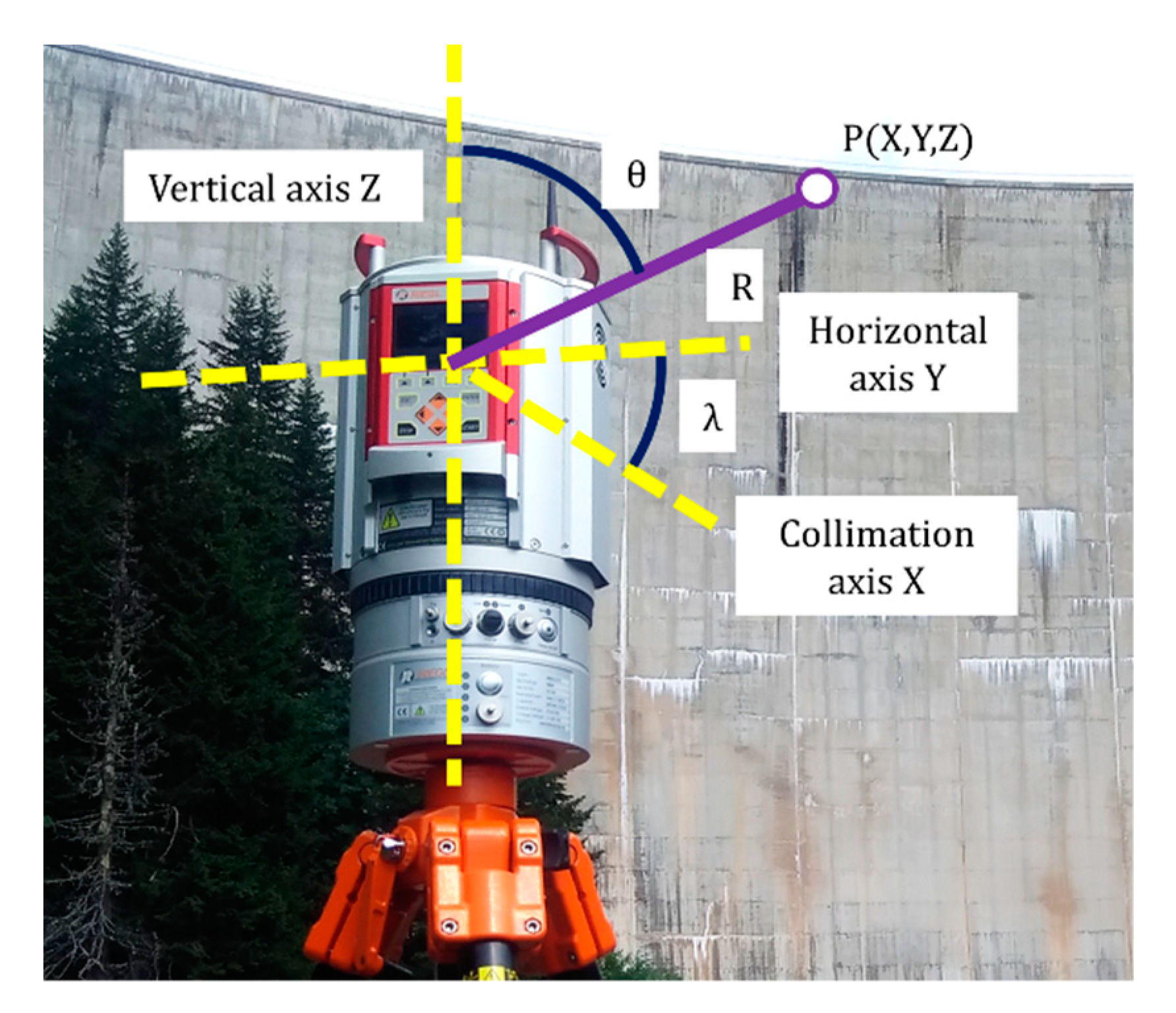
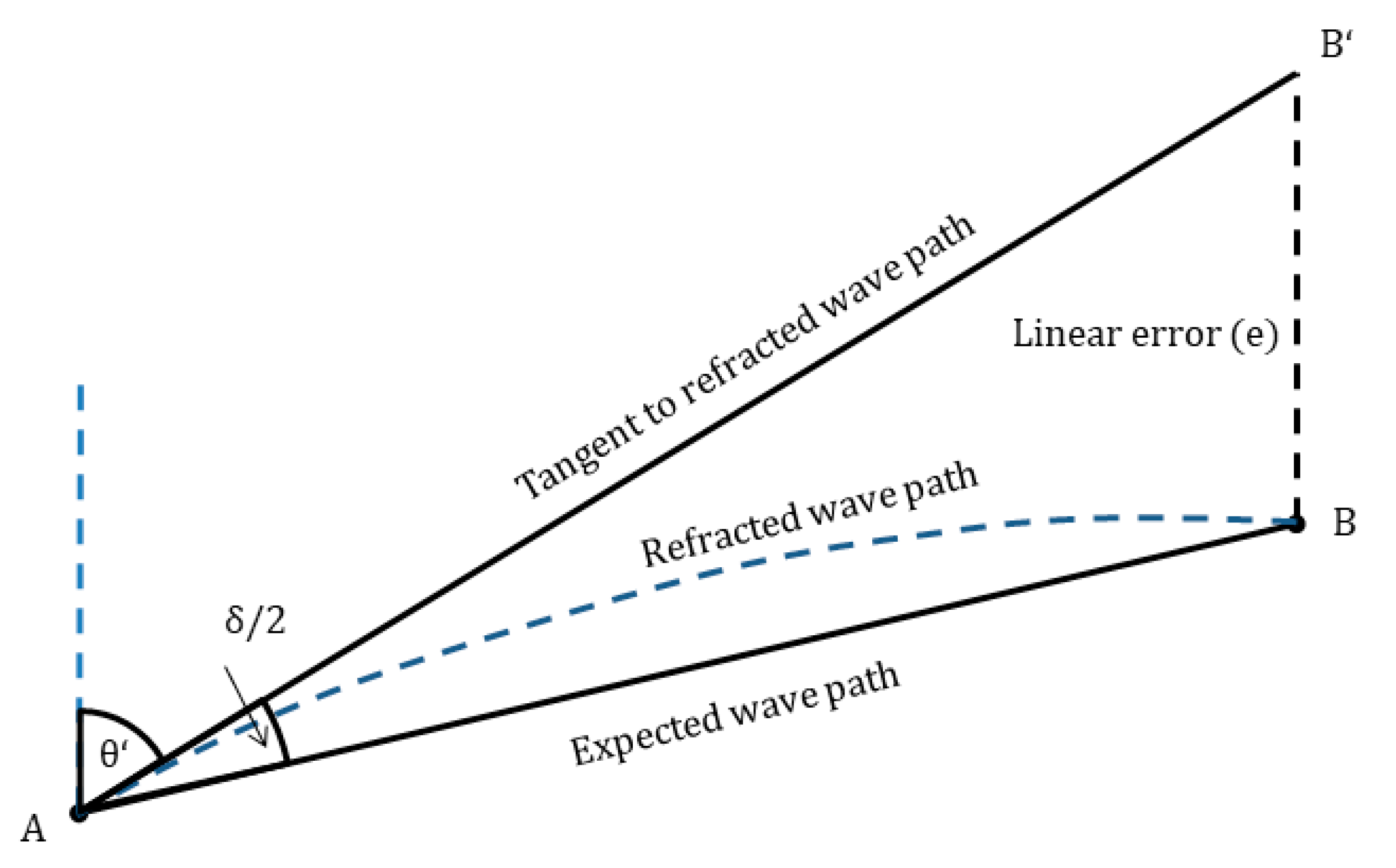

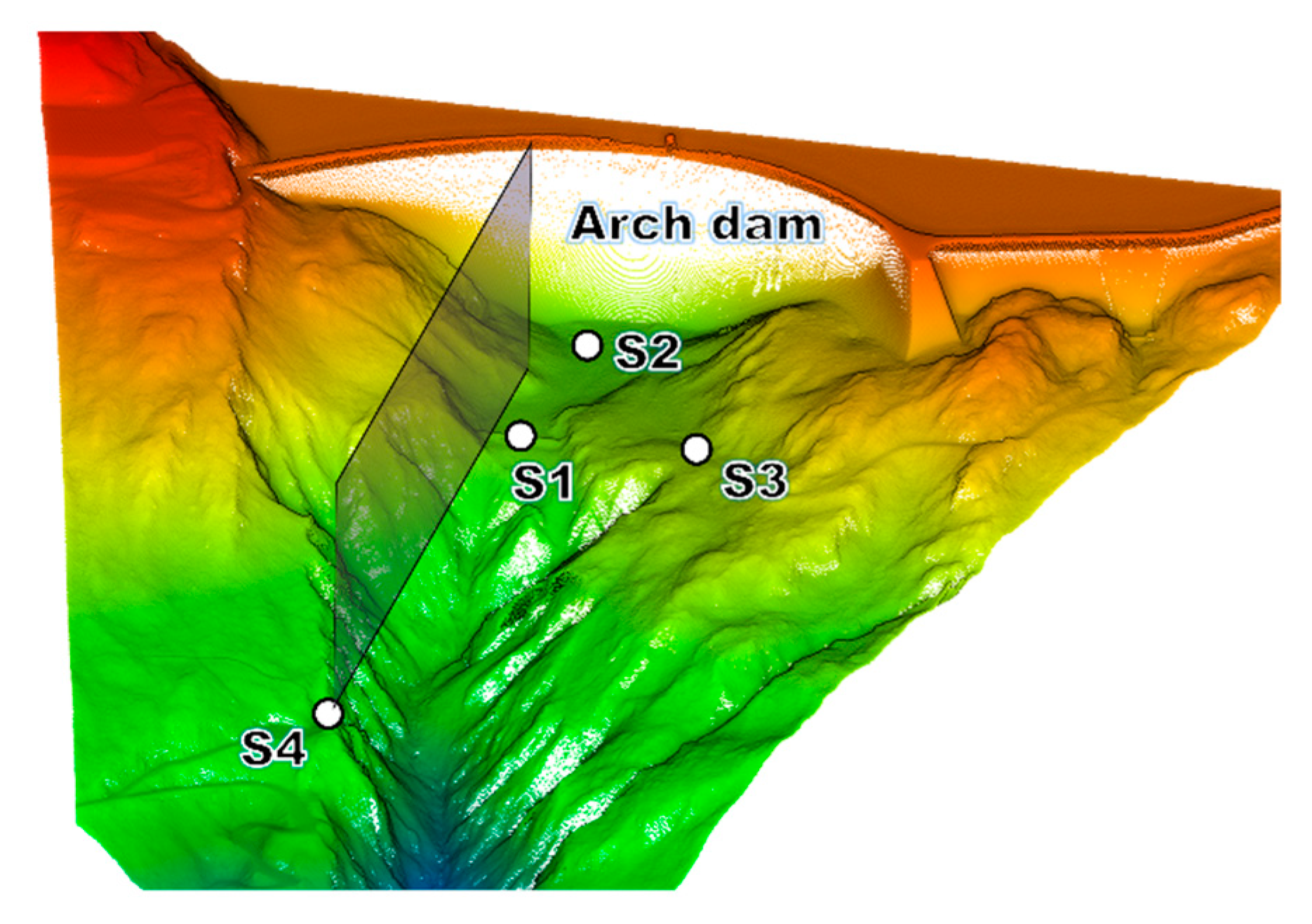
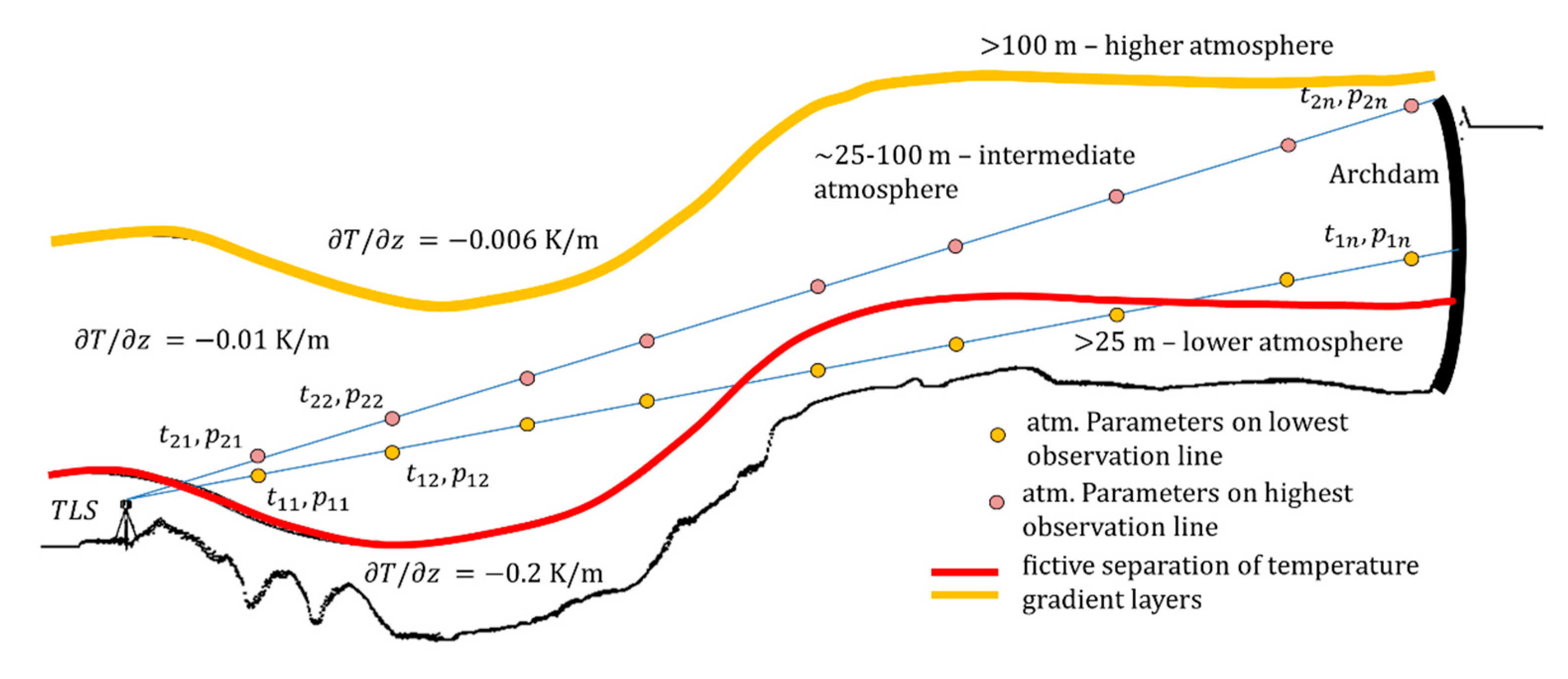
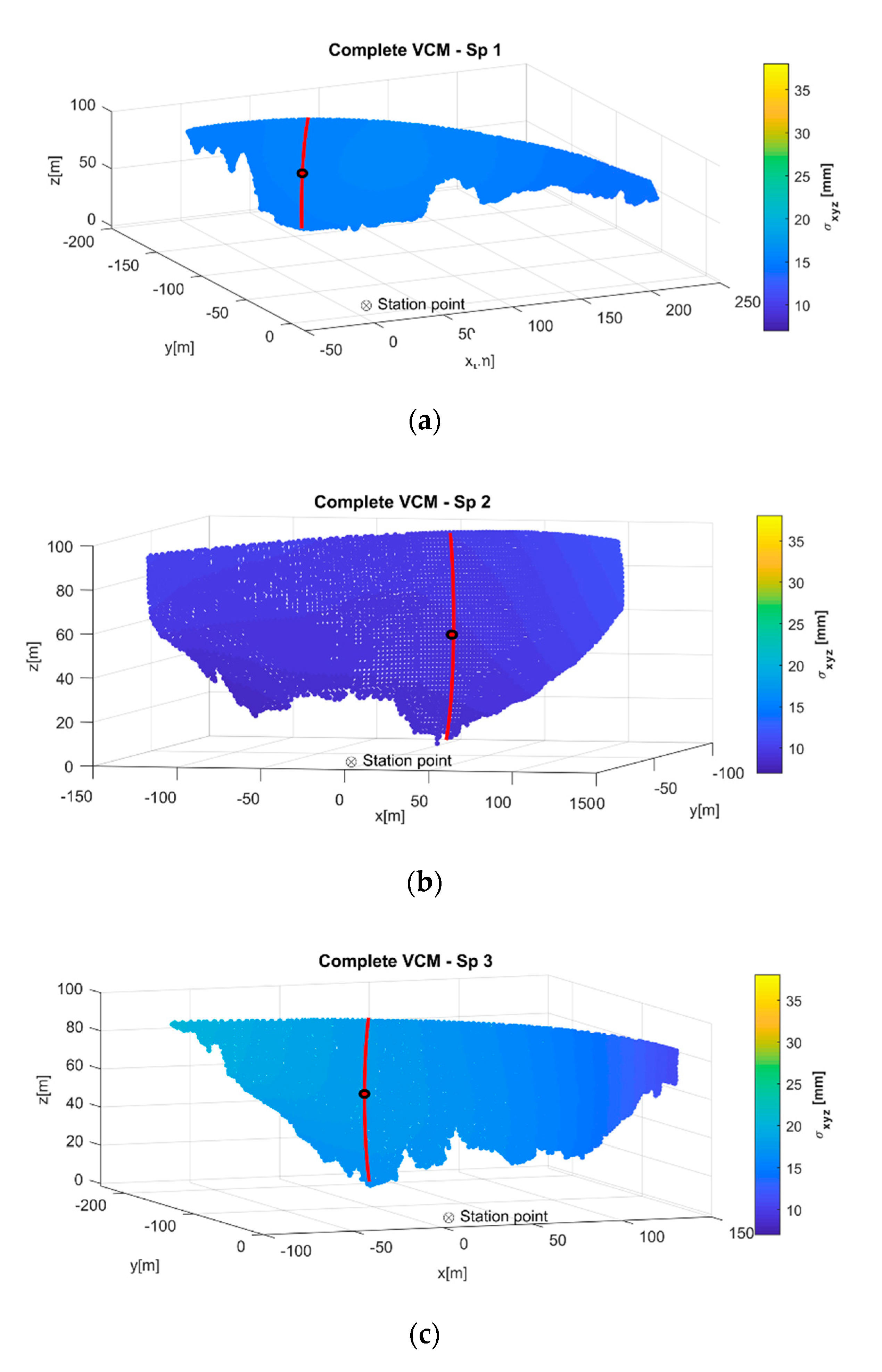
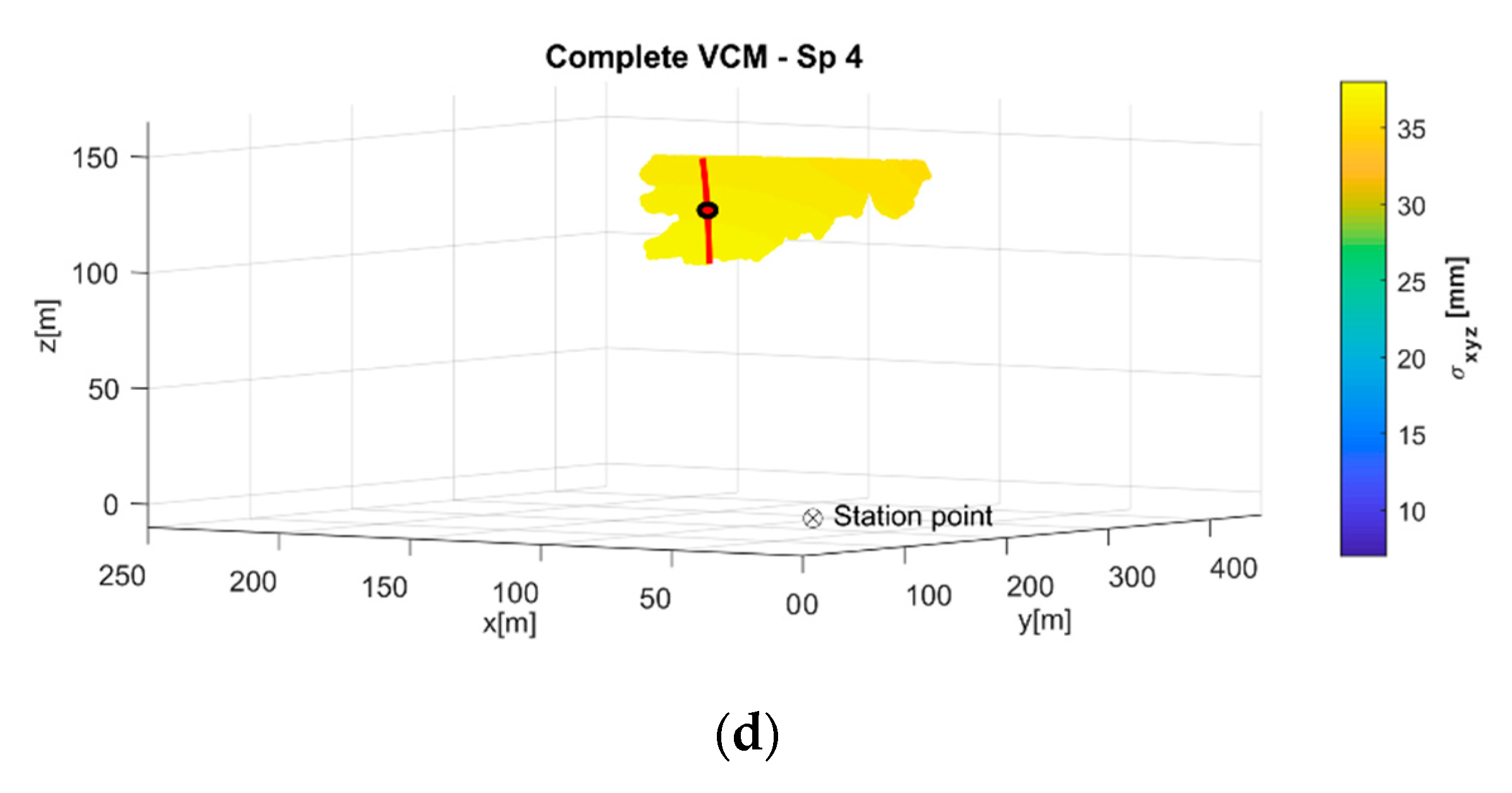
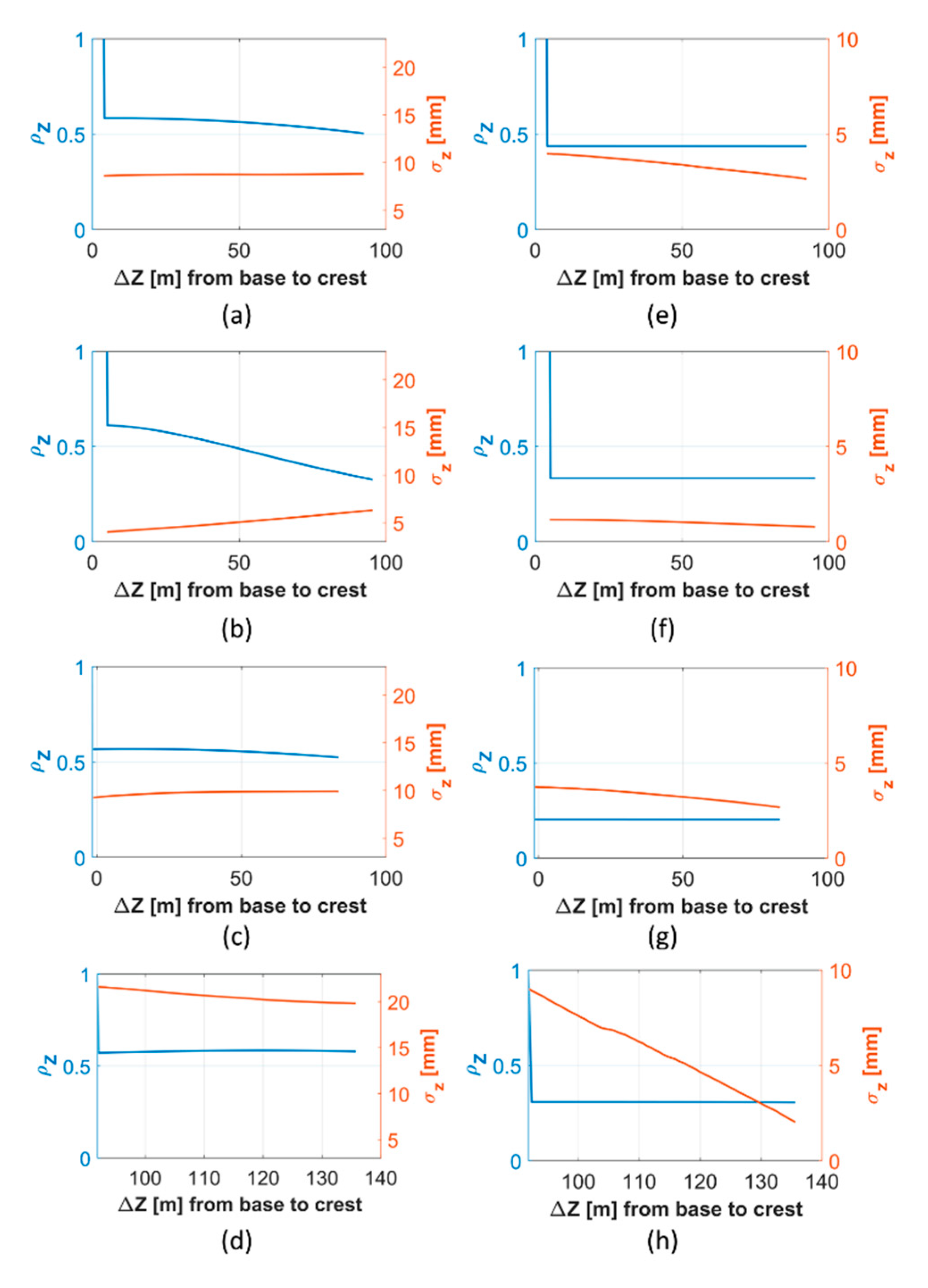
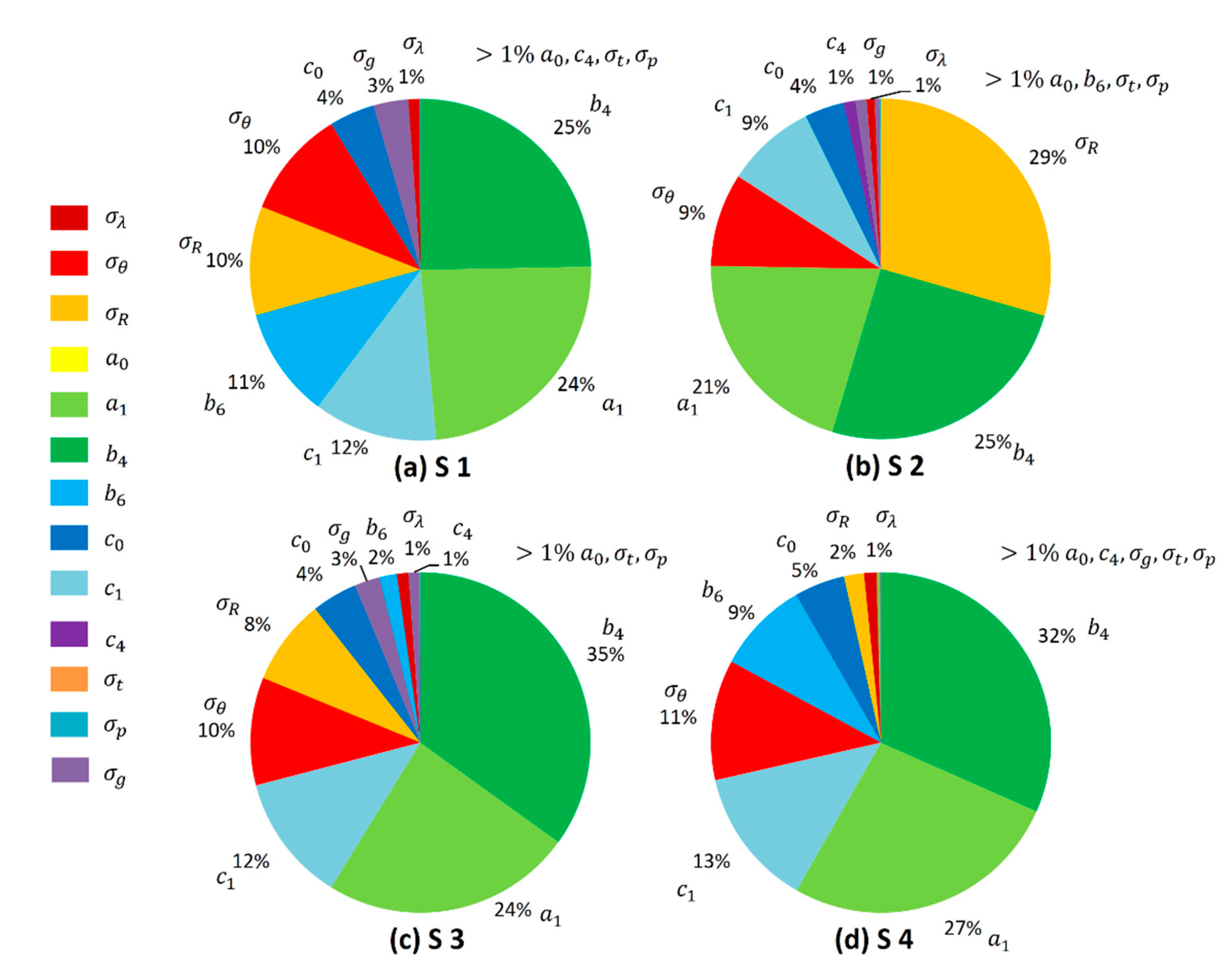
| Type of Error | Parameter | Standard Deviation |
|---|---|---|
| Non-correlating errors | Range noise | |
| Angle noise (λ, θ) | ||
| Functional correlating errors | ||
| Station Point | Shortest Horizontal Distance from Scanner to Dam | Mean Distance to Dam | Weather Conditions |
|---|---|---|---|
| S1 | 180 [m] | 194 [m] | t = 16 °C, p = 941 mbar |
| S2 | 88 [m] | 119 [m] | t = 15 °C, p = 942 mbar |
| S3 | 196 [m] | 203 [m] | t = 23 °C, p = 832 mbar |
| S4 | 456 [m] | 466 [m] | t = 24 °C, p = 840 mbar |
| Station Point | Temperature Variance from Lowest to Highest Line ( ) | Temperature Variance from Lowest to Highest Line ( ) | Temperature Variance from Lowest to Highest Line ( ) | Correlation Coefficients | |||||
|---|---|---|---|---|---|---|---|---|---|
| S1 | 0.28 … 2.36 °C | 1.55 … 3.36 hPa | 0.25 … 0.17 K/m | 0.27 | 0.08 | 0.44 | 0.19 | 0.27 | 0.10 |
| S2 | 0.17 … 1.13 °C | 1.53 … 3.44 hPa | 0.24 … 0.16 K/m | 0.28 | 0.23 | 0.33 | 0.49 | 0.18 | 0.36 |
| S3 | 1.94 … 1.78 °C | 1.54 … 3.14 hPa | 0.25 … 0.17 K/m | 0.27 | 0.24 | 0.20 | 0.59 | 0.43 | 0.35 |
| S4 | 1.88 … 1.61 °C | 4.01 … 4.78 hPa | 0.11 … 0.03 K/m | 0.48 | 0.80 | 0.31 | 0.31 | 0.63 | 0.47 |
© 2020 by the authors. Licensee MDPI, Basel, Switzerland. This article is an open access article distributed under the terms and conditions of the Creative Commons Attribution (CC BY) license (http://creativecommons.org/licenses/by/4.0/).
Share and Cite
Kerekes, G.; Schwieger, V. Elementary Error Model Applied to Terrestrial Laser Scanning Measurements: Study Case Arch Dam Kops. Mathematics 2020, 8, 593. https://doi.org/10.3390/math8040593
Kerekes G, Schwieger V. Elementary Error Model Applied to Terrestrial Laser Scanning Measurements: Study Case Arch Dam Kops. Mathematics. 2020; 8(4):593. https://doi.org/10.3390/math8040593
Chicago/Turabian StyleKerekes, Gabriel, and Volker Schwieger. 2020. "Elementary Error Model Applied to Terrestrial Laser Scanning Measurements: Study Case Arch Dam Kops" Mathematics 8, no. 4: 593. https://doi.org/10.3390/math8040593
APA StyleKerekes, G., & Schwieger, V. (2020). Elementary Error Model Applied to Terrestrial Laser Scanning Measurements: Study Case Arch Dam Kops. Mathematics, 8(4), 593. https://doi.org/10.3390/math8040593






